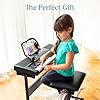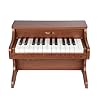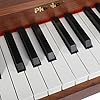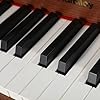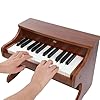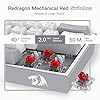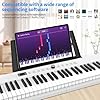Table of Contents
Introduction to Learning Piano Through Ear Training
Learning to play the piano by ear is a valuable skill that enhances musical expression and understanding. It involves developing the ability to recognize pitches, intervals, melodies, and chords purely by listening, without relying solely on sheet music. This method allows musicians to interpret and respond to music more intuitively and spontaneously. Ear training for piano not only improves your ability to play by ear but also deeply enhances your overall musicality, making it a crucial skill for both beginners and experienced players.
Developing Pitch Recognition Skills
To succeed in learning piano through ear training, developing strong pitch recognition skills is essential. Pitch recognition, or the ability to identify and replicate pitches by ear, is fundamental in translating what you hear into what you play. Here’s how you can enhance these skills:
Best Choice Products 61-Key Electronic Keyboard Piano Portable Electric Keyboard Complete Beginner Set w/LED Screen, Stand, Bench, Headphones - Black
20% OffDonner 61 Key Keyboard Piano, Electric Piano Keyboard Kit with 249 Voices, 249 Rhythms - Includes Piano Stand, Stool, Microphone, Gift for Beginners, Black (DEK-610S)
33% OffPLAMILOY Kids Piano 25-Key, Toddler Musical Keyboard Toy, Portable Wooden Electronic Keyboard for 3 Ages+, Educational Learning Gift for Boys & Girls
$89.99 (as of December 13, 2025 11:40 GMT -08:00 - More infoProduct prices and availability are accurate as of the date/time indicated and are subject to change. Any price and availability information displayed on [relevant Amazon Site(s), as applicable] at the time of purchase will apply to the purchase of this product.)The 23 Greatest Solo Piano Works
12% OffStarting with Intervals
Begin by familiarizing yourself with musical intervals, the distance between two pitches. Practice by listening to two notes and naming the interval, then try playing them on the piano. Software and apps like Tenuto or Perfect Ear can help you practice this regularly.
Working with Solfege
Using solfege (Do-Re-Mi) to train your ear helps build a mental map of pitch relationships. Start with major scales and simple songs in solfege, then advance to more complex melodies. This method enhances your ability to understand and anticipate melodies.
Engaging in Active Listening
Active listening involves paying close attention to music and dissecting its elements. Listen to a range of music and try to isolate individual piano parts or melodies. Focus on identifying patterns and try replicating them on your piano. Tools like Transcribe! and Amazing Slow Downer can slow down music without altering the pitch, making it easier to hear and learn.
Practicing with Melodic Dictation
In melodic dictation, you listen to short melodies and then try to write them down or play them back. Start simple and gradually increase complexity. This practice is excellent for improving your musical memory and reflexes in recognizing pitches.
Redragon Mechanical Gaming Keyboard Wired, 11 Programmable Backlit Modes, Hot-Swappable Red Switch, Anti-Ghosting, Double-Shot PBT Keycaps, Light Up Keyboard for PC Mac
40% OffLogitech K270 Wireless Keyboard for Windows, 2.4 GHz Wireless, Full-Size, Number Pad, 8 Multimedia Keys, 2-Year Battery Life, Compatible with PC, Laptop, Black
33% OffRedragon K617 Fizz 60% Wired RGB Gaming Keyboard, 61 Keys Hot-Swap Compact Mechanical Keyboard w/White and Grey Color Keycaps, Linear Red Switch, Pro Driver/Software Supported
$44.99 (as of December 13, 2025 16:23 GMT -08:00 - More infoProduct prices and availability are accurate as of the date/time indicated and are subject to change. Any price and availability information displayed on [relevant Amazon Site(s), as applicable] at the time of purchase will apply to the purchase of this product.)EPOMAKER x Aula F75 Gasket Mechanical Keyboard, 75% Wireless Hot Swappable Gaming Keyboard with Five-Layer Padding&Knob, Bluetooth/2.4GHz/USB-C, RGB (Light Blue, LEOBOG Reaper Switch)
15% OffUtilizing Technology
Make use of technology designed for ear training. Apps like Yousician, Flowkey, and Simply Piano listen to you play and provide real-time feedback, which aids in improving your pitch accuracy and timing. They often include games and challenges that make learning more engaging.
Learning to Play Songs by Ear
Learning to play songs by ear on the piano is a valuable skill that enables musicians to play more freely and creatively. It involves recognizing chord progressions, melodies, and rhythms without the need for written music. Here’s how you can improve your ability to play songs by ear:
Developing Active Listening Skills
To play music by ear, the first step is to develop strong active listening skills. Actively listen to a wide variety of music and focus on distinguishing the different elements such as melody, harmony, and rhythm. Try to identify patterns in music, such as common chord progressions and melody structures, which often repeat in many songs.
Understanding and Identifying Chords
Knowledge of chords is crucial for playing by ear. Start by learning major and minor chords, then gradually move to more complex structures like seventh chords and diminished chords. Practice by listening to music and trying to identify the chords being used, starting with simple songs and gradually increasing complexity.
Learning Transcription
Transcription is the practice of writing down or playing out a piece of music that you hear. Begin with simple melodies—listen to a melody and try to play it back on the piano. Move on to Transcribing entire chord progressions and later, full songs. This process greatly enhances your ear training and helps you understand musical patterns more deeply.
Playing with Others
Playing music in a group setting can sharpen your ability to play by ear. When you play with others, you often don’t have the chance to rely on sheet music, which forces you to listen and adapt to the music being played in real-time. This can accelerate the development of your ear training skills.
Sing The Melodies
Singing melodies before trying to play them on the piano can be incredibly beneficial. It helps internalize the musical notes and gives you a clearer idea of how they should sound on the piano. Once comfortable, translate your singing into playing, aiming to match the pitch and rhythm closely.
Utilizing Technology
Several apps and software can assist in ear training. Utilizing these tools can provide structured practice and feedback, which is crucial for improvement. Examples include apps that quiz you on recognizing intervals, chord types, and other aspects of music theory.
Consistent Practice
Like any musical skill, the ability to play by ear improves drastically with regular and deliberate practice. Dedicate time each day specifically for ear training exercises alongside your regular piano practice sessions.
Understanding Chord Progressions by Listening
Learning to understand chord progressions through listening is a vital skill for developing musicians, especially for pianists who aim to master playing by ear. This skill involves recognizing the sequence of chords in a song and understanding how these chords work together to create music.
Start with Basic Chords: Begin by listening to simple songs that use common chord progressions such as I-IV-V-I (e.g., C-G-Am-F). Focus on identifying these chords by ear. Try listening to different genres to expose yourself to various chord combinations and progressions.
Identify the Root Movement: Pay attention to the bass line as it often plays the root note of the chord. Noticing how the bass note moves can help you determine the progression of chords. Practice by attempting to play along with the bass line and then adding the corresponding chords.
Use Tools and Apps: Utilize ear training apps specifically designed for recognizing chords and progressions. These tools offer structured training and feedback, which can accelerate your learning process.
Practice Chord Inversions: Chord inversions can make chord recognition more challenging. Learn to identify not just the basic triad form but also the inversions where the root, third, or fifth of the chord is played in different positions.
Develop a Repertoire of Chord Progressions: Familiarize yourself with a variety of progressions by learning songs across different styles of music. This practice will develop your ability to anticipate and recognize common progressions during listening.
Transcribe Music: Try to transcribe music by listening to it. Start with simple tunes and gradually move to more complex pieces. Transcribing not only helps in identifying chord progressions but also enhances general ear training skills.
Play with Others: Playing music with other musicians can vastly improve your ability to listen and adapt to different chord progressions and styles of play. It provides a real-time and practical setting to apply your listening skills.
Understanding chord progressions by listening is a critical skill for anyone learning piano through ear training. Consistent practice across these techniques will deepen your understanding and increase your adaptability as a pianist.
Practicing Interval Training on the Piano
Interval training is a fundamental aspect of ear training on the piano. It involves recognizing the distance between two notes, which is crucial for developing the ability to play by ear. Below are detailed methods to practice interval training effectively.
Begin by familiarizing yourself with simple intervals such as major and minor seconds, thirds, and perfect fifths. Play these intervals on the piano repeatedly, and listen closely to their distinctive sounds.
Associate each interval with a song that starts with the same interval to help in memorizing their sound. For example, the theme from “Jaws” can be associated with a minor second, and “Here Comes the Bride” with a perfect fourth.
As you play each interval on the piano, sing along with it. This technique helps solidify the sound of the interval in your memory and enhances your ability to recognize it without the piano.
Once comfortable with simple intervals, start practicing with random intervals. Play two random notes and identify the interval between them. This practice helps develop the skill of recognizing intervals in a less structured and more real-world scenario.
Several apps and software tools are designed to assist in interval training. These tools typically play intervals, and users need to identify them. They provide immediate feedback and are incredibly beneficial for consistent practice.
Practice playing scales on the piano but focus on identifying the interval between successive notes. This not only aids in interval training but also in understanding how intervals form the structure of scales.
As proficiency improves, challenge yourself with more complex intervals, such as augmented and diminished intervals. Recognizing these less common intervals is crucial for advanced ear training.
Practicing intervals with a metronome helps improve your timing and rhythm alongside interval recognition. Set the metronome to a comfortable pace and play different intervals in rhythm, gradually increasing the speed as you improve.
Using Technology to Enhance Ear Training
Learning piano through ear training has been greatly enhanced with the use of technology. Various tools and applications are now available that streamline the process, making it accessible and efficient. Here are some ways in which technology can be utilized:
Interactive Apps
Several mobile and desktop applications have been designed to improve listening skills and music theory knowledge. Apps like Perfect Ear, Tenuto, and EarMaster offer exercises that include interval recognition, chord distinctions, and rhythm training. These applications often use a game-like format to keep learning both fun and educational, providing instant feedback and progressively challenging levels.
Online Music Games
Online platforms like Theta Music Trainer and Musictheory.net provide a variety of games focused on ear training and music theory. These games cover areas such as pitch identification, scale construction, interval recognition, and chord progressions, which are fundamental for developing a strong ear for music. The interactive experience enhances engagement and retention of musical concepts.
Virtual Piano Software
Software such as Synthesia or Flowkey not only teaches users how to play the piano but also incorporates ear training by letting users play along with any MIDI file. These programs display notes and chords visually, and can adjust to the pace of the learner, making it easier to connect what is heard with what is being played.
YouTube Tutorials and Play-Along Videos
YouTube has become a valuable educational resource for pianists. Many channels offer play-along videos and tutorials that teach you to play by ear. These videos can be paused and replayed, providing learners the ability to learn at their own pace. Channels often cover popular songs as well as classical pieces and include tips on ear training.
Recording Software
Using recording software such as Audacity or GarageBand helps learners record their own sessions and playbacks. This allows for self-assessment and immediate feedback, making it possible to hear one’s own mistakes and areas needing improvement. Additionally, these tools can manipulate recordings to isolate melodies, change tempos, or even keys, aiding in deeper musical understanding and adaptability.
Digital Metronomes and Tuners
Metronomes and tuners are essential for any musician. Digital versions of these tools are available as standalone devices or as apps, which help develop a sense of tempo and tuning. Playing along with a metronome is particularly useful in training one’s ear to maintain consistent timing. Tuning apps help ensure the instrument is well-tuned, which is crucial for accurate ear training and musical performance.
Conclusion
In conclusion, learning the piano through ear training provides a deeply intuitive and rewarding approach to music education. This method not only enhances your ability to play by ear but also improves your overall musicality. With consistent practice, a focus on active listening, and practical application through improvisation and transcription, you can develop a robust set of skills that allow for a more expressive and responsive piano playing experience. By integrating these strategies, learners will find themselves well-equipped to tackle a wide range of musical challenges with confidence and finesse.





